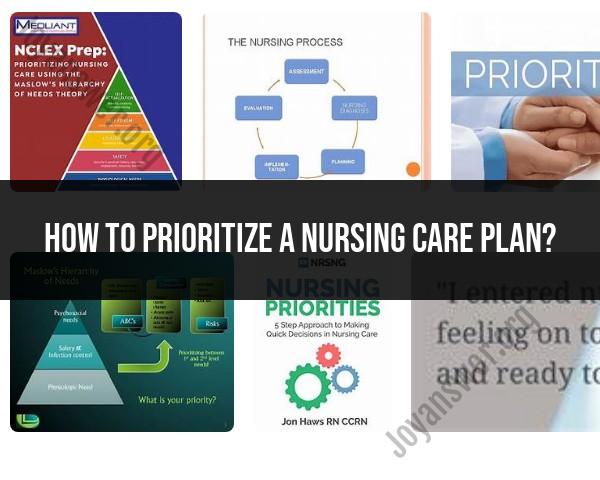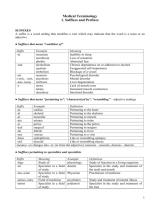How to prioritize a nursing care plan?
Prioritizing a nursing care plan is a critical aspect of providing effective patient care, especially in fast-paced and high-stress healthcare settings. Here are some key considerations and steps for prioritizing a nursing care plan:
Assessment: Begin by conducting a thorough assessment of the patient's condition. Collect all relevant data, including the patient's medical history, vital signs, laboratory results, and any specific complaints or concerns.
Identify Urgent Needs: Determine if there are any immediate, life-threatening issues that require immediate attention. For example, a patient with difficulty breathing or unstable vital signs would be a high-priority case.
ABCs: The ABCs stand for Airway, Breathing, and Circulation. In emergency situations, these should be the top priority. Ensure the patient has a clear airway, is breathing effectively, and has stable circulation.
Pain Management: Pain can significantly impact a patient's comfort and well-being. Assess the patient's pain level and provide appropriate pain management interventions if needed.
Prioritize Based on Maslow's Hierarchy of Needs: Consider the patient's physiological, safety, love and belonging, esteem, and self-actualization needs according to Maslow's hierarchy. Ensure that basic physiological needs are met first.
Assess Coexisting Conditions: Consider any coexisting medical conditions, such as comorbidities, allergies, or medication interactions, that may affect the patient's care and prioritize accordingly.
Patient's Preferences: Always consider the patient's preferences and values when setting priorities. Ensure the care plan aligns with the patient's goals and values.
Consult with the Healthcare Team: Collaborate with other healthcare professionals, such as doctors, specialists, and therapists, to ensure a coordinated approach to care.
Reevaluate and Adjust: Continually reassess the patient's condition and adjust priorities as needed. Conditions can change, and new information may emerge during the course of care.
Document and Communicate: Accurate and timely documentation is essential. It ensures that all members of the healthcare team are aware of the patient's status and plan of care.
Time Management: Efficient time management is crucial in healthcare. Allocate your time based on the priority of tasks. Delegate appropriate tasks to other members of the healthcare team when necessary.
Patient Education: Provide the patient and their family with necessary education about their condition, treatment plan, and any self-care they may need to perform. Education should be tailored to their understanding and needs.
Ethical Considerations: Consider any ethical dilemmas that may arise and involve the appropriate ethics committee or consult with a healthcare ethicist when necessary.
Cultural Competence: Be sensitive to the patient's cultural, spiritual, and religious beliefs. Respect their preferences and practices when planning care.
Delegation: When working in a team, delegate tasks to appropriate team members based on their competencies and scope of practice.
Effective prioritization in nursing care is a dynamic process that requires ongoing assessment, communication, and collaboration with the healthcare team. It's essential to maintain flexibility and adaptability to provide the best care possible to your patients while ensuring their safety and well-being.
Prioritizing Nursing Care Plans: Strategies for Success
Maslow's Hierarchy of Needs: Prioritize nursing care plans based on the patient's most basic needs, such as airway, breathing, and circulation. Once these needs are met, move on to higher-level needs such as safety, love and belonging, esteem, and self-actualization.
ABCDE Method: Use the ABCDE method to assess and prioritize patient needs. ABCDE stands for:
- Airway
- Breathing
- Circulation
- Disability
- Exposure
Nursing Diagnosis Ranking: Rank nursing diagnoses based on their severity, urgency, and potential for complications.
Collaborative Care: Collaborate with other healthcare providers to identify and prioritize patient needs.
Patient-Centered Care: Involve the patient and their family in the prioritization of care.
The Core Elements of a Nursing Care Plan
- Nursing Diagnosis: A statement of the patient's actual or potential health problem.
- Goals: Measurable statements of what the patient is expected to achieve.
- Interventions: Actions taken by the nurse to help the patient achieve their goals.
- Evaluation: The process of assessing the patient's progress towards their goals.
Triaging and Ranking Nursing Interventions for Patient Care
- Triaging: The process of prioritizing nursing interventions based on their urgency and importance.
- Ranking: The process of assigning a priority level to nursing interventions.
Dynamic Nursing Care Plans in Fast-Paced Healthcare Settings
- Flexibility: Nursing care plans must be flexible to meet the changing needs of patients.
- Adaptability: Nurses must be able to adapt nursing care plans based on new information or changes in the patient's condition.
- Communication: Nurses must communicate effectively with other healthcare providers about changes to nursing care plans.
Adapting to Evolving Patient Needs in Nursing Care Planning
- Ongoing Assessment: Nurses must continuously assess the patient's needs to identify any changes.
- Reevaluation: Nurses must regularly reevaluate nursing care plans to ensure that they are still meeting the patient's needs.
- Collaboration: Nurses must collaborate with other healthcare providers to develop and implement changes to nursing care plans.













